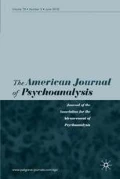Abstract
Whether encountered as a movie or novel, Roald Dahl’s Charlie and the Chocolate Factory is a childhood staple of postwar Anglophone culture. Originally published in 1964, Dahl’s story of “Willie Wonka” is a morality tale for our times addressed by the present essay in relation to the precariousness, violence, intergenerational faith, and materialist fantasies reflective of contemporary life in the early twenty-first century. Compensating for the precarity of contemporary life’s impoverishment as assumptions of societal stability are overthrown, this chronicle of the Bucket family details: envious desire validated by large group chosen trauma; authoritarian enslavement of inferior, colonized peoples with murderous, industrial-level human experimentation; toward gratification of the greedy fantasy of unlimited sweetness under the sway of lethal identification with the aggressor.
Similar content being viewed by others
REFERENCES
Anderson, E., & Cissna, K. (1957). The Martin Buber–Carl Rogers dialogue: A new transcript with commentary (p. 1997). Albany, NY: State University of New York Press.
Bion, W. R. (1962). The psycho-analytic study of thinking. International Journal of Psychoanalysis, 43, 306–310.
Bion, W. R., & Bion, F. (2005). The Tavistock seminars. London: Karnac.
Burton, T. (2005). Charlie and the chocolate factory (motion picture). US: Warner Bros.
Cervantes, M. (1605). Don Quixote (E. Grossman, Trans., p. 2003). New York: Harper Collins.
Dahl, R. (1964). Charlie and the chocolate factory. New York: Alfred Knopf.
Eco, U. (1985). On ‘Krazy Kat’ and ‘Peanuts’. The New York Review of Books, 32(10), 16–17.
Frankfort, H. (2005). On Bullshit. Princeton, NJ: Princeton University Press.
Freud, S. (1900). The interpretation of dreams. Standard edition (Vols. 4–5, pp. 1–627). London: Hogarth.
Freud, S. (1910). Five lectures on psycho-analysis. Standard edition (Vol. 11, pp. 1–56). London: Hogarth.
Freud, S. (1911). Formulations on the two principles of mental functioning. Standard edition (Vol. 12, pp. 213–226). London: Hogarth.
Freud, S. (1919). The “Uncanny”. Standard edition (Vol. 17, pp. 217–252). London: Hogarth.
Freud, S (1923). The infantile genital organization. Standard edition (Vol. 19, pp. 139–146). London: Hogarth.
Jones, A. (General Editor) (1968). The Jerusalem Bible. Reader’s edition. Garden City, NY: Doubleday.
Kilborne, B. (2014). Trauma and the unconscious: Double conscience, the uncanny and cruelty. American Journal of Psychoanalysis, 74, 4–20.
Lasch, C. (1979). The culture of narcissism. New York: W. W. Norton.
Margulies, S., Wolper, D. (Producers), & Stuart, M. (Director). (1971). Willy Wonka and the chocolate factory (motion picture). US: Paramount.
Miller, I. (2015). On minding and being minded: Experiencing Bion and Beckett. London: Karnac.
Rank, O. (1914). The double. A psychoanalytic study (edited by H. Tucker, Jr., Trans., p. 1971). Chapel Hill, NC: University of North Carolina Press.
Schulz, C. (1950–2000). Peanuts. US: United Features Syndicate. 1950–2011. Universal Uclick. 2011–present.
Volkan, V. (2001). Transgenerational transmissions and chosen traumas: An aspect of large-group identity. Group Analysis, 34, 79–97.
Volkan, V. (2013). Large-group-psychology in its own right: Large-group identity and peace-making. International Journal of Applied Psychoanalytic Studies, 10, 210–246.
Who exactly are the 1%? (2012, January 21). The Economist. http://www.economist.com/node/21543178#print.
Winnicott, D. W. (1949). Hate in the counter-transference. International Journal of Psychoanalysis, 30, 69–74.
Author information
Authors and Affiliations
Additional information
Address correspondence to Ian S. Miller, Ph.D., Kilmainham Congregational Church, Inchicore Rd., Dublin 8, Ireland; email: driansmiller@gmail.com.
Rights and permissions
About this article
Cite this article
Miller, I.S. READING WILLY WONKA IN THE ERA OF ANTI-THINKING. Am J Psychoanal 78, 113–125 (2018). https://doi.org/10.1057/s11231-018-9139-4
Published:
Issue Date:
DOI: https://doi.org/10.1057/s11231-018-9139-4



